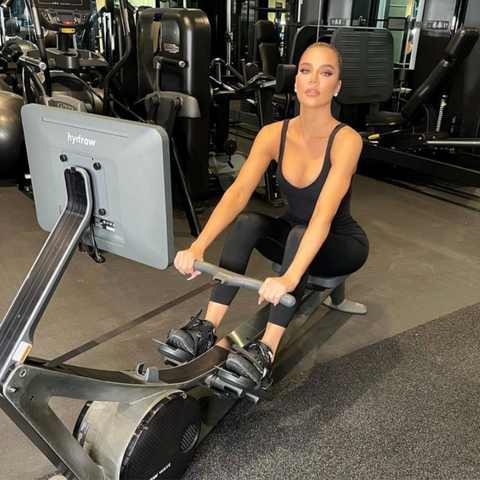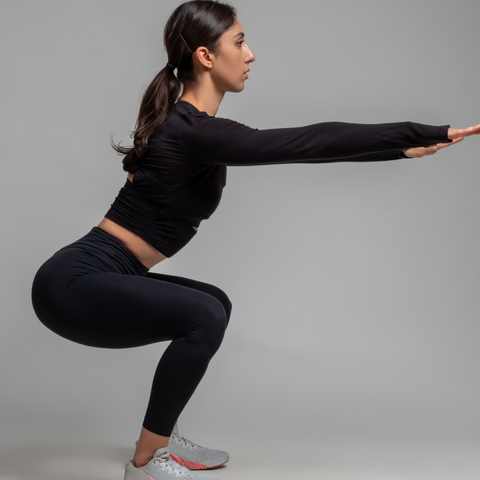The elliptical machine, when used correctly, has tons of excellent benefits for people of all fitness levels. And whether you’re looking for a low-impact workout routine, a high-intensity one that will have you dripping in sweat, or simply want to improve your cardiovascular health, an elliptical machine workout will help you hit your goals.
We’re about to get into all of the reasons why every gym goer should find a place for elliptical workouts in their exercise routine.
Table of Contents:
- What is the Elliptical?
- 14 Benefits of the Elliptical
- Drawbacks of the Elliptical
- What Muscles Does the Elliptical Work?
- How to Use and Program the Elliptical
- FAQs

What is the elliptical?
An elliptical is a cardiovascular machine that is a mash-up of the exercise bike, stair climber, and treadmill. It replicates a running motion, but it does so in a way that puts less strain on your joints.
If you’ve ever watched someone performing elliptical machine workouts from the side, you’ll notice their feet and legs move in an oval, hence the machine’s name.
Even though it mimics running, your feet never leave the revolving foot platforms, which means your body doesn’t experience the excess force that an exercise like running places on your joints. Most elliptical machines also have handles to engage the upper body as well.
The elliptical enables users to safely elevate their heart rate and reap all the benefits of cardiovascular training while decreasing stress on their joints. Exercisers can use programs on the screen interface or simply hop on and choose the quick start option.
While using the machine you can increase the resistance to make it more challenging, increase your stride frequency, or amp up the incline. Despite being stationary, the elliptical machine is versatile and great to add to your workout split.
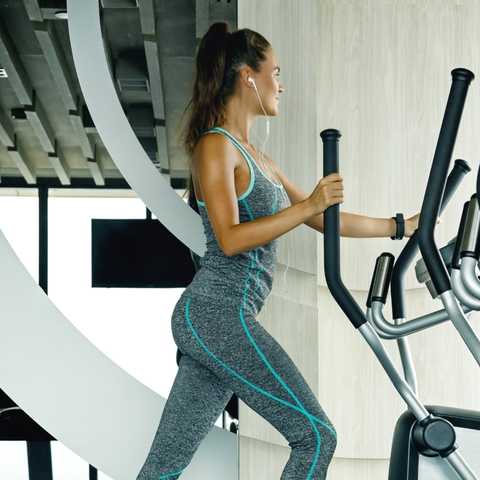
14 Benefits of Elliptical Machines
Looking for a reason why you should start using the elliptical? We’ll do better than that and give you 14 elliptical machine benefits instead!
1. It’s easy on your body.
One of our favorite benefits of an elliptical machine is that it’s an amazing low-impact workout for people rehabbing an injury, elderly gym goers, or those who have put their bodies through too much wear and tear. It significantly reduces the weight your body is bearing, particularly compared to running.
It is highly effective at helping rehabilitate people who have undergone soft tissue, bony, or lower limb surgical procedures, enabling them to bounce back faster from injury1. It is also a great way to train smarter and ensure you aren’t developing overuse injuries. The less pounding on your body, the better.
2. It’s a full body workout.
Most cardio machines are only good for a lower body workout, but the elliptical activates the upper body as well due to the push-pull mechanism of the handles. This makes the elliptical a great full body workout, ideal for toning your upper and lower body muscles.
Even if you choose not to hold onto the handles, your core will still get a workout as it works to keep your body upright, leading to postural benefits.
3. It mimics your gait pattern.
As we mentioned earlier, the machine was designed to be a low-impact option that mimics running or walking. The shape of the movement on the machine replicates the natural path of the ankle, hip, and knee joints.
Some ellipticals even have foot pedals that conform to your stride, further increasing the benefits of the machine.
4. It’s weight-bearing (but not overly so).
It’s important to note that the elliptical is not as weight-bearing as running, which makes it much easier on your body. But it doesn’t remove this aspect entirely.
The elliptical is still more weight-bearing than an exercise bike or rowing machine. This plays a role in osteoporosis prevention and keeps your bones strong.
5. Elliptical machines improve coordination.
Looking for more benefits of elliptical machines? We’re not even close to being done yet!
Here’s another: Since it’s a full-body exercise that mimics the gait cycle, the elliptical does a great job connecting one side of the body to the other. Doing this will help improve your walking or running as well as your proprioception, balance, and body awareness.
The elliptical has a greater degree of inter-limb coordination than walking or the treadmill2. And the more coordinated you are, the better.
6. An elliptical machine is versatile.
Even though you remain stationary, the elliptical machine is full of options, such as pre-programmed workouts, to change up your routine.
It also has a straightforward, easy-to-use quick start option that allows you to hop on and move through a wide range of intensities, including moving to warm up, performing a low-intensity steady-state cardio session, or finishing your workout with a shorter HIIT-style routine.
As you work out, you can increase the resistance, making it feel as though you’re walking through mud and challenging your muscles, or you can increase the incline, which changes the focus to your leg muscles, forcing your glutes, calves, and hamstrings to work as though you’re walking up a hill.
Ellipticals even allow you to move forward or backward, changing the muscles targeted.
7. Elliptical workouts boost heart health.
Cardiovascular training on the elliptical is an excellent option for lowering your blood pressure and improving how well your heart functions.
And despite how easy it may look, the elliptical can potentially get your heart rate higher than the treadmill3. The better your heart and lungs work, the better you’ll feel.
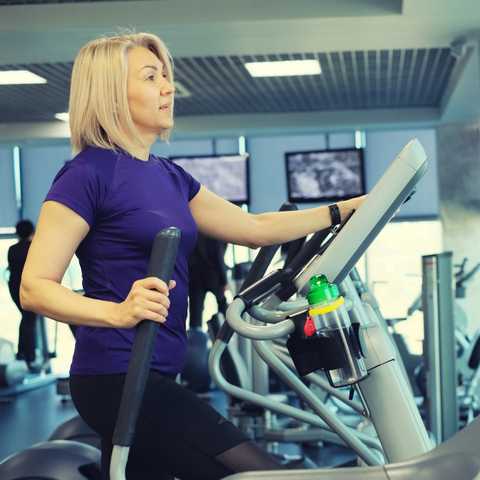
8. The elliptical trainer burns calories.
One of the best benefits of the elliptical machine is that due to its ability to get your heart rate so high, it is great for burning calories.
You can burn anywhere from 250-400 calories in around 30 minutes on an elliptical4. And when you are trying to lose weight, it all comes down to calories in vs. calories out.
For best weight loss results, make sure to pair your elliptical training with a good diet plan, such as counting macros, the vegan diet, or the 80 20 rule diet.
9. Ellipticals increase quad and hip strength.
The elliptical was designed to mimic your natural gait, but it has a slightly bigger range of motion compared to walking.
This leads to a larger degree of knee and hip flexion, meaning that while on the elliptical, you can strengthen your quads and hips slightly more than you’re able to with standard walking5.
10. An elliptical machine workout will improve your mood.
You’ve likely heard of the runner’s high concept. This means that when you are in the zone during a cardio workout, your body releases endorphins that put you in a euphoric state.
You may not always feel fantastic before starting a workout, but almost every time, after finishing, you feel great and accomplished. Aerobic exercise has even been shown to decrease depression6.
11. Ellipticals increase stamina.
Your heart is also a muscle and needs exercise. We’ve already covered how well the elliptical can elevate your heart rate to get more blood pumping.
In addition, the elliptical also has benefits for your lungs and stamina. The more oxygen your body can consume while exercising, the longer and harder you can exercise.
Running, like doing these HIIT treadmill workouts, may sometimes feel harder, but research shows that the elliptical has the same oxygen consumption rates as a treadmill and stair stepper7.
12. The elliptical is great for all fitness levels.
The cool thing about the elliptical is that anyone can use it. It can be as easy as you want it to be or as excruciatingly hard as you’d like.
If you are brand new to the gym and have never used exercise equipment, the elliptical is an easy, safe option to kick-start your cardio training.
13. An elliptical is a good addition to a strength training session.
Whether you are warming up for a tough leg day or using it as a workout finisher, the elliptical is an incredible tool for elevating your heart rate.
You can even hop on for a short interval after each strength training set. This gives you the benefits of strength training combined with cardiovascular training.
14. You can multitask on it.
OK, this option isn’t as much a fitness elliptical workout benefit as it is a mental benefit. But it should help motivate you to spend more time on the piece of exercise equipment, so it all ties in.
Most ellipticals come with a tv screen that allows you to watch whatever cable channels your gym has access to, and almost all of them also come with a tray so you can place a book on it.
We’ve all been there, and sometimes we need a good distraction from our workout, whether that’s reading a book, doing something on your iPad, or watching a show.
And who knows? You may start to enjoy your sweat sessions even more when you can look forward to exercising while reading a good book!

Drawbacks of the Elliptical
Like with most things in life, there are pros and cons to an elliptical. We’ve just discussed elliptical trainer benefits, and now here’s a look at the drawbacks.
1. It’s a little awkward:
Even though it’s designed to mimic your gate, the elliptical can feel somewhat awkward for some. If your machine has fixed foot pedals, depending on your body type, the gait may feel unnatural.
This, combined with the extended range of motion for your knees and hips, could lead to muscle imbalances or overuse injuries. Most ellipticals are designed for people of average height, so if you are an outlier in that category, it may do more harm than good, particularly if you use it a lot.
2. Elliptical workouts can be boring:
Cardio is often something people dread doing, and staying in one place the entire time can make it more challenging to push through your training session.
The elliptical can sometimes be boring. If you need to move around a lot or lose focus quickly, it may not be for you. Watching a show or reading a book while you exercise can also help you power through especially if using one for an active recovery session.
3. Ellipticals don’t build strength:
It’s a great option to tone your entire body and burn calories, but it’s not going to actually build muscle and strength.
Remember that an elliptical is a cardio tool that needs to be used alongside a resistance training program.
4. An elliptical requires less joint strength:
If you are rehabbing an injury or want to avoid stress on your joints, then the elliptical is a perfect option.
However, if you aren’t recovering from an injury, since it’s less weight-bearing, you won’t receive the joint strengthening benefits of a full-weight-bearing exercise.
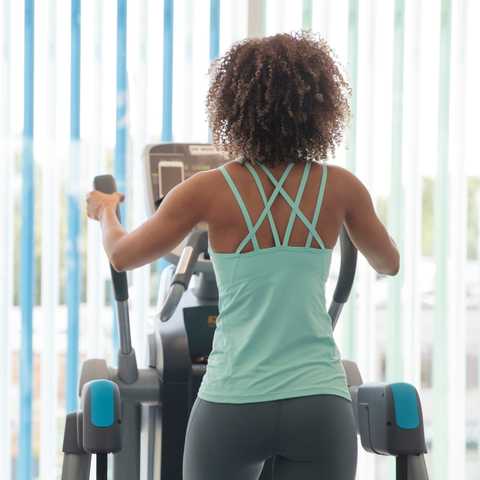
What Muscles Does The Elliptical Work?
As a full-body exercise, an elliptical is an excellent option for toning your muscles. In addition, the elliptical perfectly connects the upper and lower body.
When you hop on the elliptical, your entire lower body is hard at work. Your core works to keep you upright and stable, and the pushing and pulling of the elliptical’s handles ensure all of your upper body muscles are also fully activated.
Interested in learning more about the muscles you’re working during elliptical workouts? Make sure to check out our comprehensive article that digs into which muscles the elliptical works!

How to Use & Program Elliptical Trainers
Before starting, it’s essential to have a plan. What are you looking to accomplish with your elliptical workout? Is it going to be a low-intensity steady-state session at the end of your strength training, a heart-pounding yet low impact cardio workout, a warmup, or an intense HIIT routine?
Once you know how you will be incorporating the elliptical into your fitness routine and cardio workouts, plan your rate of perceived exertion, with 0 being easy enough to chat on the phone and 10 being completely out of breath.
Before you hop on your cardio machine, look at the computer interface and find the quick start, resistance, and incline options if they are available. Now that you have a plan and know how to use the buttons, it’s time for the easy part. Step on the machine and start pushing the handles and moving your legs!
Here are a few options for how to program the elliptical in your workout:
- As a warmup, you can hop on the machine for 5-10 minutes to get some blood flowing before you start your workout.
- As a high-intensity interval training (HIIT) option try performing 10 rounds, including 20 seconds at an easier jogging-like pace and 40 seconds either faster or increasing the resistance to make it more challenging.
- If you want to add some bodyweight movements to your basic aerobic workouts for a cardio and strength combination, try doing 3 minutes on the elliptical at an easy pace before hopping off to perform 25 push-ups and 25 bodyweight squats. Hop back on for 3 minutes at a medium speed and then jump off again, performing the same number of push-ups and squats as before. Do one more 3-minute interval at an all-out pace and hit the squats and push-ups one more time. Repeat for as many rounds as you have the time and energy for.
Interested in more great elliptical routines? Check out this awesome elliptical workout for weight loss!

Elliptical Benefits FAQs
Let’s answer some frequently asked questions regarding ellipticals and their benefits.
Are ellipticals good for losing belly fat?
Ellipticals are great for burning calories and body toning, but nothing can spot-reduce one area of your body. Proper nutrition, strength training, and cardio are part of a complete program for losing body fat.
Is 30 minutes of elliptical enough?
Depending on your intensity during that time, the elliptical will burn around 270-390 calories. It’s enough if you work hard the entire time.
How long is a good workout on an elliptical?
If you perform a steady-state cardio session, shoot for 20-30 minutes. If you prefer HIIT training, anywhere from 10-20 minutes is good.
What is better, the elliptical or treadmill?
They are different tools that both have their strengths and weaknesses. The elliptical is easier on your joints, and the treadmill is a more dynamic athletic workout.
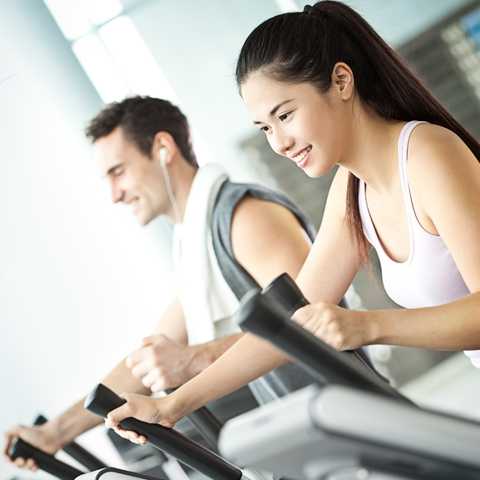
Add the Elliptical to Your Workout Routine
Whether you’re looking for cardio to incorporate into your weight lifting routine, hoping to increase your weekly LISS cardio, or are in need of a heart-pounding HIIT program, the elliptical is the right equipment for the job.
Step one is determining the type of workout you’d like to perform on the elliptical. Step two? Hop on, and get to work!
Interested in experiencing the elliptical’s many benefits from the comfort of your home? Check out our articles on the Best Elliptical Machines Under $1000 and the 8 Best Elliptical Machines For All Budgets!
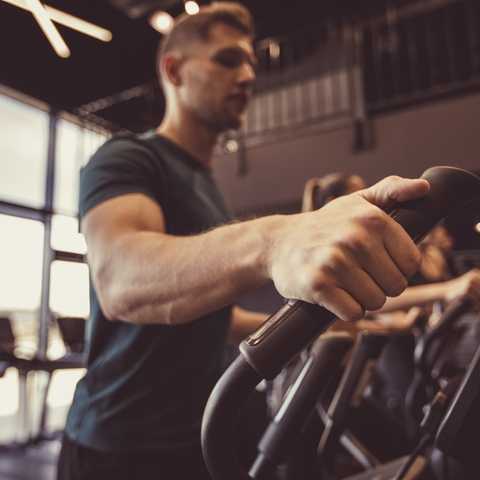
- Kaplan Y, Barak Y, Palmonovich E, Nyska M, Witvrouw E. Referent body weight values in over-ground walking, over ground jogging, treadmill jogging, and elliptical exercise. Gait & Posture. 2014;39(1):558-562. doi:10.1016/j.gaitpost.2013.09.004
- Damiano DL, Norman T, Stanley CJ, Park HS. Comparison of elliptical training, stationary cycling, treadmill walking, and overground walking. Gait & Posture. 2011;34(2):260-264. doi:10.1016/j.gaitpost.2011.05.010
- Brown GA, Cook CM, Krueger RD, Heelan KA. Comparison of Energy Expenditure on a Treadmill vs. an Elliptical Device at a Self-Selected Exercise Intensity. Journal of Strength and Conditioning Research. 2010;24(6):1643-1649. doi:10.1519/jsc.0b013e3181cb2854
- Calories burned in 30 minutes of leisure and routine activities. Harvard Health. Published July 1, 2004. https://www.health.harvard.edu/diet-and-weight-loss/calories-burned-in-30-minutes-for-people-of-three-different-weights
- Prosser LA, Stanley CJ, Norman TL, Park HS, Damiano DL. Comparison of elliptical training, stationary cycling, treadmill walking and overground walking. Electromyographic patterns. Gait & Posture. 2011;33(2):244-250. doi:10.1016/j.gaitpost.2010.11.013
- Stanton R, Reaburn P. Exercise and the treatment of depression: A review of the exercise program variables. Journal of Science and Medicine in Sport. 2014;17(2):177-182. doi:10.1016/j.jsams.2013.03.010
- Bosch AN, Flanagan KC, Eken MM, Withers A, Burger J, Lamberts RP. Physiological and Metabolic Responses to Exercise on Treadmill, Elliptical Trainer, and Stepper: Practical Implications for Training. International Journal of Sport Nutrition and Exercise Metabolism. 2021;31(2):135-142. doi:10.1123/ijsnem.2020-0155






























